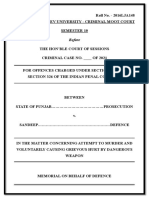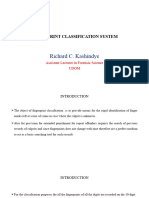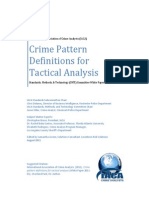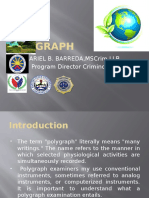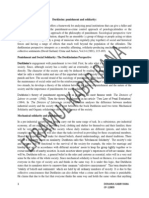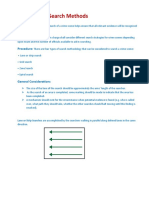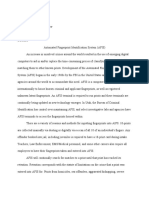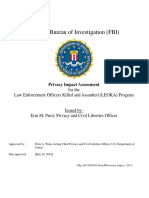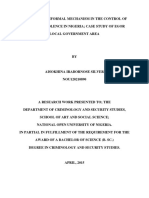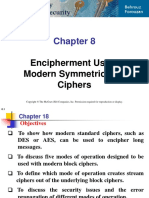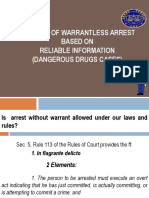Get FBI Updates: - About Us - CJIS - Fingerprints & Other Biometrics - IAFIS
Get FBI Updates: - About Us - CJIS - Fingerprints & Other Biometrics - IAFIS
Uploaded by
Karima Afandi QuiliumCopyright:
Available Formats
Get FBI Updates: - About Us - CJIS - Fingerprints & Other Biometrics - IAFIS
Get FBI Updates: - About Us - CJIS - Fingerprints & Other Biometrics - IAFIS
Uploaded by
Karima Afandi QuiliumOriginal Title
Copyright
Available Formats
Share this document
Did you find this document useful?
Is this content inappropriate?
Copyright:
Available Formats
Get FBI Updates: - About Us - CJIS - Fingerprints & Other Biometrics - IAFIS
Get FBI Updates: - About Us - CJIS - Fingerprints & Other Biometrics - IAFIS
Uploaded by
Karima Afandi QuiliumCopyright:
Available Formats
Get FBI Updates
Home About Us CJIS Fingerprints & Other Biometrics IAFIS
The Integrated Automated Fingerprint Identification System, or IAFIS, is a national fingerprint and criminal history system that responds to requests 24 hours a day, 365 days a year to help our local, state, and federal partners and our own investigatorssolve and prevent crime and catch criminals and terrorists. IAFIS provides automated fingerprint search capabilities, latent search capability, electronic image storage, and electronic exchange of fingerprints and responses. What is included in IAFIS: Not only fingerprints, but corresponding criminal histories; mug shots; scars and tattoo photos; physical characteristics like height, weight, and hair and eye color; and aliases. The system also includes civil fingerprints, mostly of individuals who have served or are serving in the U.S. military or have been or are employed by the federal government. The fingerprints and criminal history information are submitted voluntarily by state, local, and federal law enforcement agencies.
How big it is: IAFIS is the largest criminal fingerprint database in the world, housing the fingerprints and criminal histories for more than 70 million subjects in the criminal master file, along with more than 34 million civil prints. Included in our criminal database are fingerprints from 73,000 known and suspected terrorists processed by the U.S. or by international law enforcement agencies who work with us. How fast it works: The average response time for an electronic criminal fingerprint submission is about 27 minutes, while electronic civil submissions are processed within an hour and 12 minutes. IAFIS processed more than 61 million ten-print submissions during Fiscal Year 2010. When it started: IAFIS was launched on July 28, 1999. Prior to this time, the processing of ten-print fingerprint submissions was largely a manual, labor-intensive process, taking weeks or months to process a single submission. The FBI has been the national repository for fingerprints and related criminal history data since 1924, when more than 800,000 fingerprint records from the National Bureau of Criminal Identification and Leavenworth Penitentiary were consolidated with Bureau files. The first use of computers to search fingerprint files took place in October 1980. Whats new: While IAFIS has been an effective system, criminal and terrorist threats have evolved over the past decade. Todays environment demands faster and more advanced iden tification capabilities. The Next Generation Identification program, or NGI, represents a quantum leap in fingerprint identification that will help us in solving investigations, preventing crime, and apprehending criminals and terrorists. NGIwhich delivers an incremental replacement of IAFISprovides automated fingerprint and latent search capabilities, electronic image storage, and electronic exchange of fingerprints to more than 18,000 law enforcement agencies and other authorized criminal justice partners 24 hours a day, 365 days a year. Upon completion, NGI will have the ability to process fingerprint transactions more effectively and accurately. With the delivery of NGI Increment 4 in the summer of 2014, NGI will effectively replace IAFIS.
http://www.fbi.gov/about-us/cjis/fingerprints_biometrics/iafis/iafis
Five Key Services
The five key IAFIS services are:
1: Ten-Print-Based Fingerprint Identification Services A ten-print fingerprint submission contains 10 rolled fingerprint impressions and corresponding flat fingerprint impressions. Criminal Ten-Print Fingerprint Submission: Fingerprints are acquired as a result of an arrest at the city, county, state, or federal level. The fingerprints are processed locally and then electronically forwarded to a state or federal agency system for processing. The fingerprints are then sent through the CJIS Wide Area Network to IAFIS for processing. Mailed ten-print fingerprint cards are converted to an electronic format in the IAFIS environment. Civil Ten-Print Fingerprint Submission: Fingerprints are acquired for background checks for employment, licensing, or other non-criminal justice purposes where authorized by federal and state law and in compliance with appropriate regulations. To determine what occupations are authorized within your state, contact your state police or your state criminal history repository. Like criminal fingerprints, civil fingerprints are processed by local, state, or federal agencies prior to being submitted to IAFIS for processing. For information regarding taking legible fingerprints for ten-print fingerprint submissions, see "Taking Legible Fingerprints. 2: Latent Fingerprint Services IAFIS supports both electronic and hard copy submissions of latent fingerprints. It provides the FBI Laboratory with enhanced search capabilities using databases specially designed for matching latent fingerprints. Latent fingerprint specialists return decisions to the requestor and add any unidentified latent fingerprints and their features to the unsolved latent fingerprint file. 3: Subject Search and Criminal History Services The Interstate Identification Index (III) segment of IAFIS is the national system designed to provide automated criminal history record information. The Interstate Identification Index stores the criminal history record information of federal offenders and those offenders established by participating and non-participating III states. Each record is created through the submission of fingerprint images to IAFIS. The participating states establish and update records within the Interstate Identification Index through the submission of first and subsequent fingerprint images of arrested subjects. Once these records are established, the participating states provide requested criminal history records when an electronic inquiry for a state-maintained record is processed by the system. States in the final stage of the Interstate Identification Index as National Fingerprint File (NFF) participants submit only the first arrest fingerprint images of a subject to establish a pointer record within the index segment. Any subsequent activity related to this NFF pointer record will be the sole responsibility of the NFF participating state. If a direct terminal inquiry or an IAFIS fingerprint inquiry identifies a person with a criminal history in one or more NFF participating states, a criminal history request is forwarded to the participating NFF states criminal history system for the appropriate response. 4: Document and Imaging ServicesDocument Services: IAFIS processes documents associated with criminal history records received in electronic, hard copy, or machine-readable data formats. These documents include arrest dispositions, expungements, and other miscellaneous updates. For more information on criminal history document submission, seeArrest Disposition Submission. Fingerprint Image Services: IAFIS supplies electronic images of fingerprints to authorized agencies upon request. See the Electronic Fingerprint Transmission Specification (EFTS), Section 3.6-3.7 for more information. Photo Services: IAFIS has the capability to accept, store, and distribute photos. See the EFTS, Appendix K for information regarding photo submission and Section 3.10 for photo retrieval. 5: Remote Ten-Print and Latent Fingerprint Search Services IAFIS supports remote ten-print and latent fingerprint searches by law enforcement agencies. The results of remote ten-print and latent searches are returned electronically and include a list of potential matching candidates and corresponding fingerprints for comparison and identification by the requesting agency.
The FBI will provide the following remote search software packages to criminal justice agencies upon request, free of charge. Remote Fingerprint Editing Software (RFES): This complete software package performs remote searches of IAFIS. RFES supports remote IAFIS transactions, including images and feature-based searches for both ten-print and latent fingerprints. RFES editing and human interface were developed based on use and advice of both local law enforcement and FBI latent fingerprint specialists. See additional information regarding RFES (pdf). Universal Latent Workstation (ULW) Software: This latent software package performs remote latent searches of IAFIS. See additional information regarding ULW.
http://www.fbi.gov/about-us/cjis/fingerprints_biometrics/iafis/iafis_services
You might also like
- FINAL Notes in PolygraphyDocument21 pagesFINAL Notes in PolygraphyTreb Medz100% (2)
- Criminal MootDocument22 pagesCriminal MootTaran Saini100% (4)
- DoD Counterspying Terrorism and Insider ThreatsDocument13 pagesDoD Counterspying Terrorism and Insider ThreatsKarl HeinzNo ratings yet
- Latent PrintsDocument4 pagesLatent PrintsDwightNiceIINo ratings yet
- FingerprintingDocument14 pagesFingerprintingapi-148758015No ratings yet
- FP ImpressionDocument6 pagesFP ImpressionAlea May Valdez MendozaNo ratings yet
- Fingerprint Classification System IVDocument67 pagesFingerprint Classification System IVSamuels JosepNo ratings yet
- Types of Cyber CrimeDocument35 pagesTypes of Cyber CrimeRajwinder KaurNo ratings yet
- FOOTPRINTDocument11 pagesFOOTPRINTPraveen SathyaNo ratings yet
- Lesson 3 Types of Criminal Justice System in The WorldDocument1 pageLesson 3 Types of Criminal Justice System in The WorldRoliane LJ RugaNo ratings yet
- Iacawp 2011 01 Crime PatternsDocument8 pagesIacawp 2011 01 Crime PatternszmijicaNo ratings yet
- Criminal Law and Jurisprudence, Law Enforcement Administration, CriminalisticDocument211 pagesCriminal Law and Jurisprudence, Law Enforcement Administration, Criminalisticsacli.valentin mjNo ratings yet
- Learning Module 5 - Forensic ChemDocument22 pagesLearning Module 5 - Forensic ChemjohnNo ratings yet
- Polygraphy Module NewDocument85 pagesPolygraphy Module NewFranco Angelo Reyes100% (1)
- Data Interpretation PDFDocument6 pagesData Interpretation PDFBala SubramanianNo ratings yet
- Swot Analysis - Transnational CrimeDocument14 pagesSwot Analysis - Transnational CrimeCharmis Tubil100% (1)
- Methods of Impressing: at The End of This Module 3, You Should Be Able ToDocument11 pagesMethods of Impressing: at The End of This Module 3, You Should Be Able ToLea Garnace IsmaelNo ratings yet
- Professional Regulations CommissionDocument17 pagesProfessional Regulations CommissionQueen Vi BenedictoNo ratings yet
- CDI 4 ORGANIZED CRIME DomeDocument8 pagesCDI 4 ORGANIZED CRIME DomeEl Miar Opeña Rañin IINo ratings yet
- By: John Paul C. Fernandez, RcrimDocument108 pagesBy: John Paul C. Fernandez, RcrimJohn Paul FernandezNo ratings yet
- QuestionsDocument12 pagesQuestionsChristopher PjunatasNo ratings yet
- Polygraph (Lie Detector)Document52 pagesPolygraph (Lie Detector)Ayie BarredaNo ratings yet
- Discrimination Against Law Enforcement Officers On The Basis of Sexual Orientation and Gender Identity: 2000 To 2013Document51 pagesDiscrimination Against Law Enforcement Officers On The Basis of Sexual Orientation and Gender Identity: 2000 To 2013therepubliq.comNo ratings yet
- RAYMUNDA MORENO - PolygraphyDocument14 pagesRAYMUNDA MORENO - Polygraphydynamic_edgeNo ratings yet
- 1 5 16 Questioned DocumentsDocument33 pages1 5 16 Questioned Documentsapi-292927256100% (1)
- Juvenile Delinquency Handouts ReducedDocument29 pagesJuvenile Delinquency Handouts ReducedcriminologyallianceNo ratings yet
- Automated Latent Fingerprint Recognition: Kai Cao and Anil K. Jain, Fellow, IEEEDocument14 pagesAutomated Latent Fingerprint Recognition: Kai Cao and Anil K. Jain, Fellow, IEEEmadhura jaiNo ratings yet
- Cdi 3 Module - Rape InvestigationDocument53 pagesCdi 3 Module - Rape InvestigationKuya KhyNo ratings yet
- LEA4 Models of Policing HandoutsDocument5 pagesLEA4 Models of Policing HandoutsKenneth FernandezNo ratings yet
- Stages of Money LaunderingDocument4 pagesStages of Money LaunderingAlfe PinongpongNo ratings yet
- Criminology PDFDocument10 pagesCriminology PDFSankalp YadavNo ratings yet
- Criminology Key Issue Exam Questions and AnswersDocument2 pagesCriminology Key Issue Exam Questions and AnswersAbeera AliNo ratings yet
- Questioned Document Examination Reviewer - BigwasDocument32 pagesQuestioned Document Examination Reviewer - BigwasRile NyleveNo ratings yet
- Challenges Facing Criminal Justice System in Relation To Witness Protection in KenyaDocument5 pagesChallenges Facing Criminal Justice System in Relation To Witness Protection in KenyaIOSRjournalNo ratings yet
- Concept of Dispute: - Money Disputes - Encroachment of FR's - Social Dispute - Professional Misconduct - EtcDocument4 pagesConcept of Dispute: - Money Disputes - Encroachment of FR's - Social Dispute - Professional Misconduct - EtcShantanu PachaharaNo ratings yet
- Modernity and PunishmentDocument5 pagesModernity and PunishmentEkramulKabirRanaNo ratings yet
- Assignment: Discuss Three or Four Criminological TheoriesDocument44 pagesAssignment: Discuss Three or Four Criminological TheoriesAllets AtehNo ratings yet
- Essay About Role of Police Reports in The Law Enforcement CommunityDocument2 pagesEssay About Role of Police Reports in The Law Enforcement CommunitySintas Ng Sapatos100% (1)
- Polygraphy NewDocument132 pagesPolygraphy NewRovi ClaritoNo ratings yet
- PRB Crim Test ConstructionDocument19 pagesPRB Crim Test ConstructionBcfi CriminologyNo ratings yet
- RetributionDocument5 pagesRetributionDivya Bharti0% (1)
- Civil Rights and Political RightsDocument1 pageCivil Rights and Political RightsSangit NiraulaNo ratings yet
- Cflm2-Character Formation 2Document46 pagesCflm2-Character Formation 2jonas ventolinaNo ratings yet
- 2018 LEA Notes PDFDocument149 pages2018 LEA Notes PDFNigs Li100% (1)
- Review Notes in Police Personnel and Records ManagementDocument17 pagesReview Notes in Police Personnel and Records ManagementAnonymous a8cqIrW6O100% (1)
- Final TopicsDocument26 pagesFinal TopicsRoi Allen AmuraoNo ratings yet
- Routine Activity Theory: Crime PreventionDocument2 pagesRoutine Activity Theory: Crime PreventionMuhammad Azzam Alfarizi100% (1)
- Lea 1 Chapter 1 Part 2Document27 pagesLea 1 Chapter 1 Part 2Shaila GonzalesNo ratings yet
- I. Objectives/Learning Outcomes: Crim 5 (Juvenile Delinquency and Juvenile Justice System) 10Document5 pagesI. Objectives/Learning Outcomes: Crim 5 (Juvenile Delinquency and Juvenile Justice System) 10Cylla EspinozaNo ratings yet
- Personal IdentificationDocument122 pagesPersonal Identificationkarl luis100% (1)
- Introduction To Forensic ChemistryDocument4 pagesIntroduction To Forensic ChemistryMa. Theresa FloresNo ratings yet
- Lea NotesDocument81 pagesLea NotesVanessa CorpuzNo ratings yet
- Homicide Investigation Techniques and Protocols (Autosaved)Document14 pagesHomicide Investigation Techniques and Protocols (Autosaved)Maverick Abad SameonNo ratings yet
- Conatitutive PenologyDocument6 pagesConatitutive Penologygie munoz100% (1)
- Crime Scene Search MethodsDocument2 pagesCrime Scene Search MethodsVîšhwąkřmą HõńëÿNo ratings yet
- Exploring The Links in The Chain of CustodyDocument9 pagesExploring The Links in The Chain of Custodytony7540No ratings yet
- Chapter 12 Social Structural Theories of CrimeDocument5 pagesChapter 12 Social Structural Theories of CrimeKaroline Thomas100% (1)
- Criminalistics Review materialsLATESTDocument60 pagesCriminalistics Review materialsLATESTChester CuarentasNo ratings yet
- The Future of Forensic ScienceFrom EverandThe Future of Forensic ScienceDaniel A. MartellNo ratings yet
- Outlaw AfisDocument8 pagesOutlaw AfisAlbert NjauNo ratings yet
- Essay 2Document3 pagesEssay 2api-486417302No ratings yet
- Pia Leoka ProgramDocument20 pagesPia Leoka Programcynthia chenNo ratings yet
- The Role of Informal Mechanism in The CoDocument28 pagesThe Role of Informal Mechanism in The CoAdediran DolapoNo ratings yet
- Hard Case Crime - Book ListDocument2 pagesHard Case Crime - Book ListSlinkyboyNo ratings yet
- CD 2 15Document19 pagesCD 2 15RayBradleyEduardoNo ratings yet
- Bakit Gusto Mo Magsampa NG Reklamo Laban Ky Rustan Ang?Document5 pagesBakit Gusto Mo Magsampa NG Reklamo Laban Ky Rustan Ang?Vanessa May Caseres GaNo ratings yet
- Metropolitan Police StructureDocument1 pageMetropolitan Police StructureCarlosManuelVallejoPuenteNo ratings yet
- An Forensic View of Bangladesh Bank Reserve HeistDocument4 pagesAn Forensic View of Bangladesh Bank Reserve HeistShaqif Hasan SajibNo ratings yet
- Manuel MIRALLES V Hon. Sergio GO, Chair of National Police Commission and Pablo VillanuevaDocument2 pagesManuel MIRALLES V Hon. Sergio GO, Chair of National Police Commission and Pablo VillanuevaJenny Mary DagunNo ratings yet
- Criminal Law Case Digest 2Document153 pagesCriminal Law Case Digest 2Robert Mandigma100% (1)
- Gender EqualityDocument2 pagesGender EqualityMayank Agrawal100% (1)
- Section 161 of Criminal Procedure CodeDocument5 pagesSection 161 of Criminal Procedure CodeAnkita ChaurasiyaNo ratings yet
- Anti Money LaunderingDocument18 pagesAnti Money Launderingsharadkulloli100% (1)
- PCVL Nle B1 PDFDocument33 pagesPCVL Nle B1 PDFWEINDLY AYONo ratings yet
- 11 37 People V Degala GR 129292-93 June 20 2001Document1 page11 37 People V Degala GR 129292-93 June 20 2001Chamscb CNo ratings yet
- Input 9072 PDFDocument4 pagesInput 9072 PDFÅñkît PandatNo ratings yet
- Bahasa-Inggris-Brigadir 4Document4 pagesBahasa-Inggris-Brigadir 4Prasetyo AsyogiNo ratings yet
- PP Vs OrillaDocument18 pagesPP Vs Orillachard apolloNo ratings yet
- Marcelo V BungubungDocument24 pagesMarcelo V BungubungfranceheartNo ratings yet
- Kabanata 6, Si BasilioDocument7 pagesKabanata 6, Si BasilioDensel BatoonNo ratings yet
- Dear PAO ADULTERY ON LINEDocument3 pagesDear PAO ADULTERY ON LINEjustineNo ratings yet
- Online BankingDocument13 pagesOnline BankingHarmanSinghNo ratings yet
- Implementation and Effectiveness of Police Checkpoint in Cotabato CityDocument7 pagesImplementation and Effectiveness of Police Checkpoint in Cotabato CityPsychology and Education: A Multidisciplinary Journal100% (1)
- Encipherment Using Modern Symmetric-Key CiphersDocument41 pagesEncipherment Using Modern Symmetric-Key Cipherssuganya004No ratings yet
- Legality of Warrantless Arrest Based On Reliable Info (Dangerous Drugs Cases)Document23 pagesLegality of Warrantless Arrest Based On Reliable Info (Dangerous Drugs Cases)johan33535No ratings yet
- BullyingDocument15 pagesBullyingAvina MunawarNo ratings yet
- English Practice 37-46Document38 pagesEnglish Practice 37-46Minh ChuNo ratings yet
- People Vs VillalonDocument7 pagesPeople Vs VillalonCattleyaNo ratings yet
- Facebook Updated Terms of Service - 4/4/18Document8 pagesFacebook Updated Terms of Service - 4/4/18Josh TechCrunchNo ratings yet

